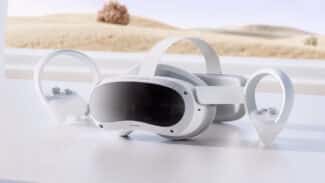Today Pico announced Pico 4, its next generation VR headset. Last month at Gamescom, we went hands-on for around 10 minutes – here are our impressions.

A New Form Factor
Taking in the headset from all angles, the new form factor is the most obvious and immediate change compared to the Pico Neo 3 Link . The front of Pico 4 is much slimmer than its predecessor – largely due to the switch to flat pancake lenses – and overall Pico say it sports a reduction in weight, down to 586g (with headstrap included) from 620g on the Neo Link 3.

Just going by the numbers, this seems like a fairly minor reduction but in practice the headset feels quite light and well-balanced. Much like the Neo 3 Link, the Pico 4 houses its battery in the back of the headstrap, which helps with even weight distribution and balance. Even though the Quest 2 is technically lighter at 503g, its weight distribution is front-loaded – all the components, including the battery, are located in the headset shell.

The reduction in weight and carrying over the back-loaded battery design will likely provide a more comfortable headset experience for most users. Personally, I found the headset to be highly comfortable on my head and easy to adjust using the top strap and tightness dial on the back. Everyone’s head is different though and your experience might vary.

More comfort improvements are found in the interpupillary distance (IPD) adjustment options. Headsets like Quest 2 and Neo 3 Link offer limited IPD adjustment with three lens positions/distances that the user can manually set before putting the headset on. However, Pico 4 offers more options with its “stepless” adjustment, allowing the user to set an exact IPD range (between 62 ~ 72mm) from within VR. This then automatically adjusts the lenses’ physical distance without requiring headset removal or manual adjustment. It’s a nifty feature that worked seamlessly in my demo and the specificity will no doubt improve comfort in VR for many users.
Field of View & Passthrough Improvements
After getting the headset on, another big upgrade immediately stuck out – the field of view. The Pico 4 sports a noticeably larger field of view than its predecessor and it’s one of the most prominent improvements. The increase in field of view is huge for immersion and improves the in-VR experience right from the get-go. The LCD display is clear and features a slightly improved resolution, but that minor display upgrade felt negligible compared to the impact of the field of view increase.
The Pico 4 also features upgraded passthrough capabilities, including a higher resolution image that’s now in full color instead of grayscale, thanks to a 16 megapixel RGB camera on the front. The upgrade is much appreciated compared to grayscale passthrough in earlier headsets like Quest 2, and it looks fantastic with the larger field of view.

The color passthrough on Pico 4 doesn’t feel like a transparent AR display or even close to one, but it’s a lot better than the grainy passthrough on Quest 2 and allowed me to make out many more details in the physical room. It’s more comfortable to use overall and will likely be more viable in situations other than just boundary setup. There could be potential for some solid mixed reality experiences using the upgraded passthrough as well – time will tell.
From my limited testing, there was some occasional perspective distortion – mainly when objects, such as my hands, were close to the camera – but given limited time with the device it’s hard to say whether that was more or less than what you’d experience on existing headsets.
Upgraded Controllers
The headset itself isn’t the only piece of refreshed piece of hardware – the Pico 4’s bundled controllers also feature a sleek new look and were an unexpected highlight. The updated design is a huge upgrade over the bulky Pico 3 controllers, now featuring tracking rings that curve above your hands and down the controllers from top to bottom.

Visually, they look somewhat similar to the upcoming PSVR 2 controllers, but with a slightly sleeker form factor. However, this isn’t just a visual upgrade – the controllers felt great to use as well. They’re well balanced and incredibly nice to hold in the hand, featuring a pleasant weight that’s both hefty and yet equally distributed.
That being said, I didn’t have enough time to properly test or assess their tracking quality and performance. Likewise, I spent most of my time with Pico 4 in the Pico OS home environment and only had very brief time with some games, including hitting a few holes in Walkabout Mini Golf. However, I didn’t play enough of any games to make substantial remarks on performance, visuals and more – you’ll have to wait for our full review for that.
Pico 4 Hands-On – Final Thoughts

When we reviewed Pico Neo 3 Link earlier this year we called it “a decent Quest 2 alternative that signals bigger things to come.” That moment may be here, as Pico 4 carries substantial improvements to field of view, alongside a slimmer front design, color passthrough and new controllers.
We’ll assess Pico 4 for a full review in the weeks ahead to see how it truly compares across far more extensive testing, but it looks well positioned to move standalone VR forward and may mark the first true competition since the debut of the original Quest in 2019.





